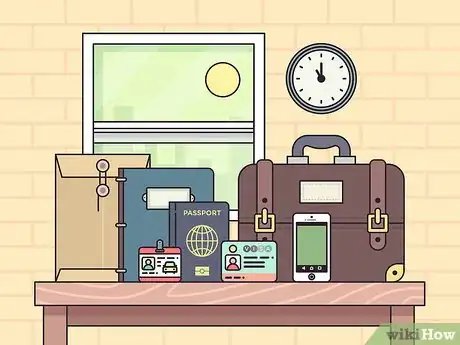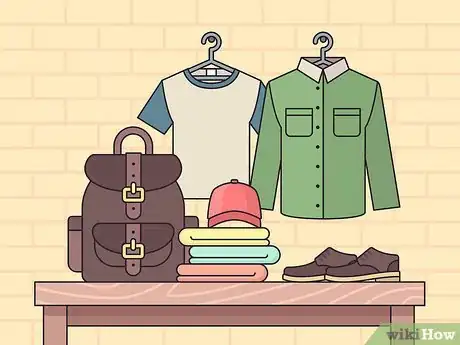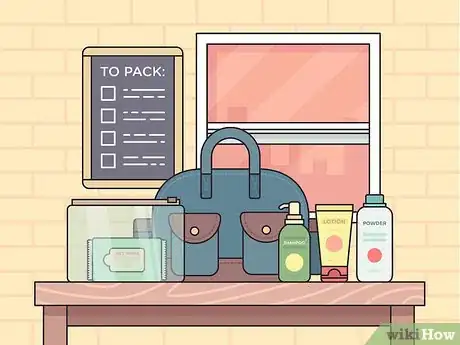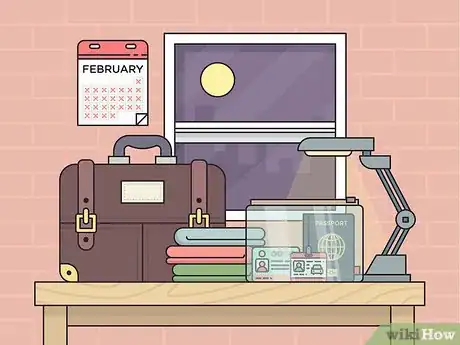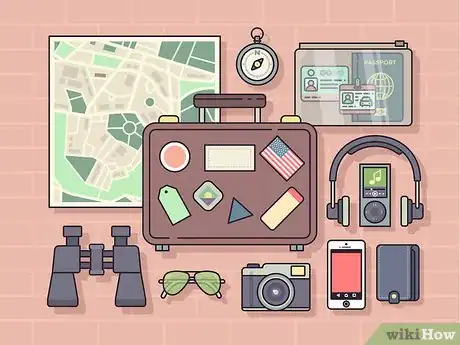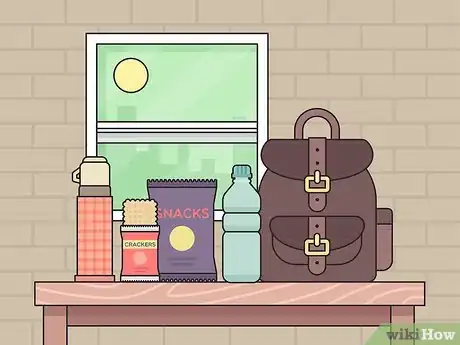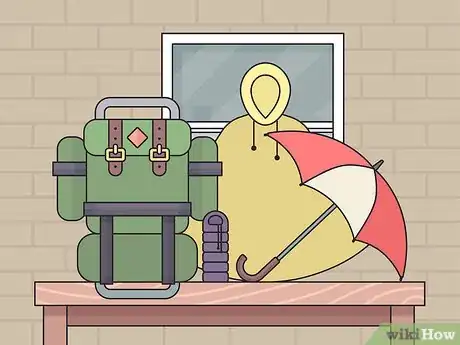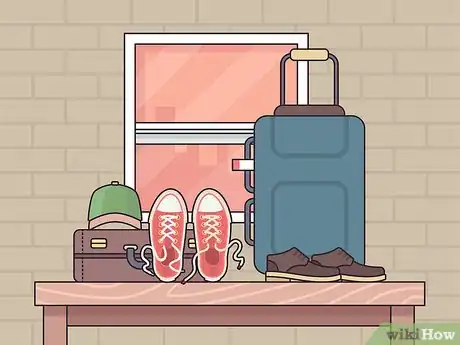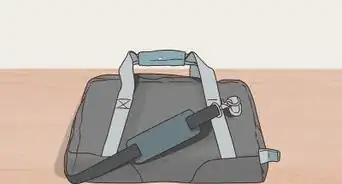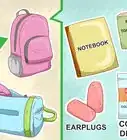This article was co-authored by Christel Ferguson. Christel Ferguson is the owner of Space to Love, a decluttering and organization service. Christel is certified in Advanced Feng Shui for Architecture, Interior Design & Landscape and has been a member of the Los Angeles chapter of the National Association of Productivity & Organizing Professionals (NAPO) for over five years.
There are 10 references cited in this article, which can be found at the bottom of the page.
This article has been viewed 155,342 times.
Packing for a two-week long trip can be daunting. It's important to remember essentials without wasting space in your luggage for items that aren't necessities. This article will help you learn methods of packing clothing and other items in order to save valuable space in your bag, while also making you realize what you may be able to live without on your next vacation or trip.
Steps
Packing List
Packing Essentials
-
1First pack items that you know you can’t live without. It’s a good idea to store any travel documents, visas and passports in a special pouch or bag where you won’t misplace them. Be sure to bring refills of any medicines that you won’t be able to replace while you’re traveling, along with toiletries that are must-haves and will be hard to find when you get there. A journal and camera are important so you can keep memories from your trip for years to come. If you’re bringing a tablet, this can double as a journal, and potentially a camera. Otherwise consider a small, point-and-shoot camera. Don’t forget that extra memory card and battery.
- We all have our trusty chap stick that we absolutely can’t live without. So if you’re worried you could run out and not be able to find an essential item on your trip, pack an extra to be safe.[1]
- Back up credit or debit cards and a photocopy of your passport and visa could come in handy if you happen to misplace these items or they are stolen.
- If your allergies occasionally flair up or you tend to get migraines, make sure you’re better safe than sorry and pack appropriate medications.
-
2Print out your itinerary to reference once you arrive at your destination and to help you stay organized from day-to-day. As a bonus you can also use this to carefully consider what you’ll need for each activity or stop on your trip. You’ll be able to easily anticipate what each day will bring. You may even notice a few items to eliminate because they won't be of use. If you aren’t entirely sure what will come in handy for each stop on your trip, research online reviews to find out what others say about the experience and what they wish they’d brought. For instance, find out if a boat trip you’re planning to take provides sunscreen and towels or if this is something you’ll need to pack.[2]
- Comfortable shoes may be the single most important item you pack. Typically this includes a pair that ties and has arch support, although it varies by person.
- Bring articles of clothing that aren’t too specific and will match with multiple items you packed. This way you won’t need to worry about what’s clean and what needs washing.
Advertisement -
3Pack in threes. Plan to bring three pairs of socks, underwear, and shirts. This way you’ll have just enough of each item to wash one, dry one, and wear one. Pants can usually be worn more than once, so two pairs should suffice. This rule only applies to the staples that you’ll be wearing everyday. If you plan to attend an event where your standard ensemble won’t be appropriate, plan accordingly.[3]
- Especially if you are traveling during the warmers months, be sure to bring clothing made of lighter fabric, such as a poly blend, which is easily packable, durable, and dries quickly.
- Only choose clothing items that you can mix and match, so they can be worn with anything you brought.
- A pair of jeans or comfortable shorts is usually a safe bet as is a pair of pants that can unzip to become shorts. These will grant you even more outfit options.
- Shirts in neutral colors like white, black and tan are likely to match with almost any bottoms. Just remember that darker colors provide more sun protection.
- If you’re traveling during cold months, plan on layering, rather than packing a heavy coat. Only the piece touching your skin will need to be washed regularly, so don’t worry about spending more time doing laundry.
- Bring a small container of laundry detergent or plan to hire a laundry service.
-
4Consider the culture and dress code for where you’re traveling and pack accordingly. This will keep you from offending the locals or sticking out like a sore thumb. The more you fit in, the less likely you are to be a target for pickpockets and people trying to take advantage of you. If you are unsure of the local customs for covering up, not exposing your shoulders and knees is a good rule of thumb.[4]
- If the culture of the visiting country is on the conservative side, a lightweight scarf won’t add bulk to your luggage but can easily and quickly cover you up.
- If you plan to attend a formal event or service, dressier clothing is necessary to show that you respect the occasion.
- An easy and quick way to dress up your everyday clothing is with accessories. For women, a piece of jewelry or a hairpiece can make even your cotton t-shirt seem dressy.
- Men can wear ties and stylish glasses with a watch to dress up their everyday duds. And the best part is that these items hardly add any weight and don’t take up room in your suitcase.
-
5Find a reputable guidebook and foreign language phrasebook. If your destination country speaks a language different from yours, it is respectful to bring along a language book to help you communicate, and of course to learn what you can beforehand. Even mastering the basic greetings or phrases for ordering meals may impress locals and show them that you’re trying.[5]
- If you plan to have phone reception or computer access, consider downloading an application for easy communication with locals. Languages and Google Translate are considered two of the best translator apps.[6]
- Especially if you expect Internet access to be limited, make sure to bring a reliable guidebook.
- Depending on the nature of your trip, look for a one that has more sections dedicated to actual activities, excursions, and landmarks, rather than accommodations. This is assuming that you have booked a place to stay before you actually arrive at your destination, so these are essentially wasted pages.
- If you’re a foodie and hoping to experience the local cuisine, then a guidebook that is heavily focused on the restaurant scene would be of most use to you.
- All good guidebooks should include ample information about the local culture and customs. Typically they’ll highlight in-depth information about transportation options as well.
- Make sure the book is current (written no longer than two or three years ago, if not the year you plan to travel). Cities change, restaurants close, and customs adapt, so to get the best experience, you need the latest information.
-
6Be prepared with appropriate containers and zip lock bags to make going through airport security a breeze. Two-ounce liquid containers can be bought at most department stores for refills of shampoo, liquid soap, or make up. Likewise department stores are likely to have sections devoted to travel sized toiletries, such as toothpaste and lotion, that you may need during your flight or for when you first land. To avoid extra fees, weigh your luggage beforehand so it doesn’t exceed your airline’s limit.
- Don’t pack anything that could be considered a weapon, such as razors or scissors, in your carry-on bag.
- Put your name and address on a tag attached to your luggage.
- Leave any agricultural products, including animal products and plants, at home.
-
7Bring books, music, your laptop and anything else to entertain you during the lengthy flight, layover, and potential delays. You can even download multiple books, movies, and songs beforehand to your tablet to save space.
- Remember to bring your own blanket and neck pillow if you’d rather not use what’s provided by the airline.
- Pack a separate carry-on bag that you can easily place at your feet with toiletries, medicines, headphones, and anything else that will make your overseas flight more comfortable.
- Earplugs and an eye mask will be especially useful for overnight flights, ensuring you’ll arrive at your destination well rested rather than jet-lagged.
Packing Styles
-
1Pack in advance to keep from panicking the night before your trip. This will give you enough time to make trips to the store if you are running low on something. Having all the items you’re packing in front of you visually may even help you make some eliminations throughout the week, saving valuable room in your suitcase.[7]
- Making a check list a week in advance will ensure you don’t forget anything valuable, as you can add to the list throughout the week. Take note of the items you use on a daily basis, chances are these are what you’ll also need on your trip.
- Consider talking to friends or acquaintances who have been to the place you’re visiting and see if they have any recommendations for what to bring. An insider’s view is usually more helpful than Internet research or a guidebook. Not only is it more personalized, but they will be able to answer your specific questions.
-
2Spread out everything you are planning to bring onto your floor. Analyze each item individually to determine the likelihood of using it during your two-week trip, and whether or not it’s something you can easily buy once you reach your destination, such as toiletries. Decide if the amount you’ll use the item justifies its weight in your bag. Do ample research on the destination so you’re fully aware of what you will and won’t have access to once you arrive.[8]
- Think in terms of items you can get by without, rather than what would be convenient on your trip. If it would be handy to have your trusty coffee press from home, but you will have easy access to inexpensive coffee on every corner, this is probably something you should leave behind.
- Use lightweight luggage, like a backpack, so more weight can be devoted to the contents. But although luggage with wheels are usually made of heavier material, they do lighten the load on your back.
- Remember hard luggage helps protect valuables inside, while soft materials are more lightweight and easily conform to fit in the luggage bin, trunk of the car, etc.
-
3Limit yourself to twenty pounds, or what you can fit into a 9 x 22 x 14 bag if you’re planning to pack everything into a carry-on. Not only will your luggage fit into the overhead bin of an airplane, but it won’t weigh you down. When you do reach your destination, you’ll enjoy mobility and spontaneity. Furthermore, everything you packed, from your toiletries down to that extra sweater, will be easily accessible. If you know there are some items you’re likely to need access to regularly, these should be placed at the top of your bag, or on the outside pockets. This will prevent you from needing to dig through all of your belongings just to find that pair of extra socks.[9]
- Carrying your bag onto the plane means it’s less prone to getting lost, broken, or stolen.
- Last minute changes in your flight itinerary will be met with less stress.
- Save on checked bag fees.
- If you’re travelling by car or train, save room in the trunk or baggage storage by keeping your bag at your feet the entire trip.
-
4Learn how to pack clothing items efficiently. This will maximize space and minimize wrinkles. Rather than folding clothes the way you typically would, rolling shirts and pairs of pants make them easier to cram into every free nook and cranny. Don’t worry, they’ll be wrinkle-free when you do take them out to wear.[10]
- To roll shirts, fold them in half and place the sleeves onto the body. Begin rolling.
- With pants just simply fold them in half with the back pockets touching, and roll from either end, making sure not to form any creases.
- To maximize space inside your bag even further, you can stick the rolled items into a compression bag, available at most travel stores. This saves room by eliminating the air between clothing. Make sure you don’t stuff too many items into each bag, and be careful of the weight, as it can add up before you realize.
- Place socks and rolled up t-shirts inside your shoes.
- Wear your shoes and other bulky items during travel. This will save room and weight in your bag.
- Layer shirts or sweaters if you’re really tight on space.
- To save space, you can roll ties, fold them, or pack them with your suit jacket.
Packing vs. Buying
-
1Pack toiletries sparingly. Items like toothpaste, shampoo, soap, and most first aid supplies can most likely be bought at your destination. So if you’re exceptionally tight on space, plan to make a pharmacy stop once you arrive. Sometimes part of the experience includes something as simple as a trip to the local market to pick up handmade Shea butter with which to replace your usual body lotion. However, if you do plan to do this, researching whether or not you’ll be able to find all of your essentials is important to do beforehand. If your final destination is a remote area of Alaska and you plan to buy a toothbrush there, it might be an uncomfortable two weeks.[11]
- Part of this is also understanding that products in a foreign country might not be exactly what you’re used to, but embracing these differences is part of the fun.
-
2Leave food and beverages behind unless they are completely necessary. Most likely, partaking in local food and drink customs is going to be a substantial part of your trip. However, even if you don’t plan on eating out at restaurants, or there won’t be many where you’re going, stopping at a grocery store along the way or once you’ve arrived is your best bet, rather than trying to pack food from home. Not only will bringing food take up more space and add excess weight, but if it's unrefrigerated, it won't last long anyway.[12]
- If there is a packaged food you can’t live without, remember to leave space for it while you’re packing clothing and other items. Be sure to include this in your packing list as well.
- Bring a collapsible water bottle or plan to buy one at your destination to reuse for the duration of your trip.
-
3Don’t necessarily take up valuable suitcase space with rain gear. Consider the weather forecast and location before packing these items. Unless you’re going somewhere that has exceptionally rainy weather, such as the Pacific Northwest, the weather forecast during your two-week stay should let you know if it’s worth it to bring boots, raincoats, and umbrellas. While nothing is likely to ruin your trip more than being unprepared for a rainstorm, these items also take up a significant amount of space for something you may possibly never remove from your bag.[13]
- Pack waterproof shoes and a rain jacket that can also double as your regular walking shoes and coat. This means you won’t have to waste any extra space for your rain gear, but will still be equipped should it start to drizzle.
- Travel size umbrellas don’t take up much space and can come in handy during a light shower.
- If the forecast is wrong and it does start to rain, you’ll most likely still find a disposable poncho to buy at your destination.
-
4Bring extra walking shoes. Don’t plan to just buy extras as needed once you arrive: these usually need to be broken in. Sometimes you don’t know if a shoe is right for your foot until you’ve worn it for a while. Finding out on your trip that the toe portion is too narrow, could put a damper on all that sightseeing you wanted to do.[14]
- Even the best, most comfortable sneakers are likely to cause a blister or two after extensive wear. So even if it’s just a comfortable sandal with ample support, don’t be left without an extra pair of shoes.
- This won’t be inexpensive to purchase when you arrive, especially if you’re in a touristy area.
- You won’t have planned on packing an extra pair of shoes, which can take up a lot of space on the way back.
Expert Q&A
Did you know you can get expert answers for this article?
Unlock expert answers by supporting wikiHow
-
QuestionHow can I pack smarter?
 Christel FergusonChristel Ferguson is the owner of Space to Love, a decluttering and organization service. Christel is certified in Advanced Feng Shui for Architecture, Interior Design & Landscape and has been a member of the Los Angeles chapter of the National Association of Productivity & Organizing Professionals (NAPO) for over five years.
Christel FergusonChristel Ferguson is the owner of Space to Love, a decluttering and organization service. Christel is certified in Advanced Feng Shui for Architecture, Interior Design & Landscape and has been a member of the Los Angeles chapter of the National Association of Productivity & Organizing Professionals (NAPO) for over five years.
Professional Organizer
-
QuestionWhat if I have 1 suitcase and have a lot to bring?
 Community AnswerRoll up all clothes and put any small objects into open areas in shoes, hats, suitcase side pockets, etc.
Community AnswerRoll up all clothes and put any small objects into open areas in shoes, hats, suitcase side pockets, etc. -
QuestionIs it necessary to purchase a special travel handbag? Is a medium to large sized handbag okay to take on a plane and boat?
 Community AnswerYes, a regular handbag is okay to take on boats and planes. On a plane, usually you will be asked to stash your bag in the overhead compartment or under the seat during takeoff and landing.
Community AnswerYes, a regular handbag is okay to take on boats and planes. On a plane, usually you will be asked to stash your bag in the overhead compartment or under the seat during takeoff and landing.
References
- ↑ http://wwwnc.cdc.gov/travel/page/pack-smart
- ↑ http://www.lonelyplanet.com/round-the-world-travel/best-of-round-the-world-travel/content/travel-tips-and-articles/how-to-pack-light-tips-from-a-master-packer
- ↑ http://www.lonelyplanet.com/round-the-world-travel/best-of-round-the-world-travel/content/travel-tips-and-articles/how-to-pack-light-tips-from-a-master-packer
- ↑ http://www.independenttraveler.com/travel-tips/passports-and-international-travel/10-things-you-should-never-wear-when-traveling-abroad
- ↑ http://www.travelnotes.org/Travel/sep9.htm
- ↑ http://www.socialnomics.net/2013/03/13/10-of-the-best-iphone-apps-for-translating-languages/
- ↑ https://www.ricksteves.com/travel-tips/packing-light/packing-list-women
- ↑ https://www.ricksteves.com/travel-tips/packing-light/packing-smart
- ↑ https://www.ricksteves.com/travel-tips/packing-light/packing-smart
- ↑ http://www.independenttraveler.com/travel-tips/packing-and-accessories/packing-tips
- ↑ http://blog.tortugabackpacks.com/what-not-to-pack/
- ↑ https://www.ricksteves.com/travel-tips/packing-light/packing-smart
- ↑ http://www.independenttraveler.com/travel-tips/packing-and-accessories/what-not-to-pack
- ↑ http://www.independenttraveler.com/travel-tips/packing-and-accessories/what-not-to-pack
About This Article
To pack for a two week trip, start by packing the things you can’t live without, such as medications and must-have toiletries. If you’re traveling by plane, makes sure to pack things like shampoo and liquid soap in airline-approved containers and zip lock bags. Next, group clothes like shirts, socks, and underwear in threes so you’ll always have 1 item to wear while the other 2 are being washed or dried. Then, fold the clothes in half and roll them up to make it easier to cram them into your luggage. For more advice, including how to pack for long flights and potential delays, keep reading.

